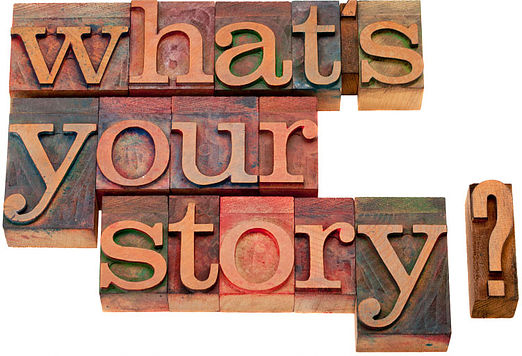 by beCause Associate John Seaman and his Saybrook Partner Robert Ferguson
by beCause Associate John Seaman and his Saybrook Partner Robert Ferguson
Storytelling is all the rage these days.
In a world that is swimming in content, more and more organizations have begun using stories to sell products and services, build support for a strategy or agenda, or shape public perception. Unfortunately, many of the stories they choose to tell are superficial or inauthentic, serving only to undermine the very goals they hope to achieve. For truly compelling stories, organizations should look to their own heritage.
What kind of stories work, and why
Storytelling may be popular, but that doesn’t mean it’s a fad. In fact, the power of stories is well documented in the literature on narrative psychology. As social creatures, our happiness and well being, sometimes even our survival, depends in large part on the relationships we forge with others. Stories let us understand and empathize with those around us, giving us the confidence we need to make common cause. Stories also trigger emotional responses that are powerful drivers of motivation—more powerful than rational argument.
Telling stories, of course, does not come naturally to busy executives who are accustomed to communicating through data and metrics, not character and plot. And when times are good and consensus is easy to achieve, there is no reason for them to step out of their comfort zone. But when the economy turns south, crisis engulfs their firm, or competition bites, or when they just need to take the organization in a new direction, leaders realize they must articulate a compelling narrative: where we are, how we got there, and where we need to go. To craft such a story, many of them turn to the mini-industry of experts—”brand storytellers” or “chief storytelling officers” are popular monikers—that has sprung up to support them. Some, as Fast Company recently pointed out, go so far as to hire novelists.
This is treating the symptom, not the disease. Even the most artfully crafted story is worthless if is inauthentic, which is to say unrecognizable in the context of the company or person telling it (just ask any of current crop of US presidential candidates who have spent millions on advertising only to see their poll numbers fall through the floor). In our experience, the most powerful story of all—one that is compelling, authentic, and true—is rooted in one’s own experience. Smart organizations and their leaders know this. They act deliberately to capture what we call “heritage stories”— founding myths, remembered events, survival stories—and use them to help crystallize a sense of purpose, engage people in transformational change, and make them feel a part of something larger than themselves.
Five heritage stories and their impacts
1. Instill a sense of mission and purpose
KPMG, the accounting firm, is one such organization. In 2014, faced with a growing, increasingly disconnected global workforce, the firm launched a major employee engagement initiative that hoped to unite people around a common, higher purpose. They captured hundreds of stories, past and present, that illustrated the impact of KPMG’s auditing and tax work in historic events: the administration of the Lend-Lease Act during the Second World War that provided US military aid to Britain and other allies; the resolution of conflicting financial claims that facilitated the release of US hostages in Iran in 1981; and the certification of the 1994 election of Nelson Mandela as the first president of post-Apartheid South Africa. By focusing more on the firm’s transcendent purpose (how it helps people) and less on its transactional purpose (what it does or sells), KPMG’s initiative had a dramatic impact on employee retention and morale, making it the number one ranked Big Four firm among FORTUNE’s 100 Best Companies to Work For.
2. Pave the way for a next generation of leaders
At Dimensional Fund Advisors, heritage stories became a vital part of succession planning. As the firm approached its 30th anniversary, Dimensional’s founder and co-CEO, David Booth, knew that a series of forces—geographical expansion, a proliferation of new funds, a large influx of new employees, and structural changes in organization and management—had combined to transform the enterprise he had built. He also knew that 30 years in business was no accident; it was the consequence of discrete decisions, many of them taken early on, that had permanently shaped the firm’s culture and values. So he engaged historians to help him craft an authoritative narrative that described those early decisions, put the firm’s subsequent development in perspective, and explained how all of this made the firm distinctive. The narrative became the basis for ongoing dialogues with young leaders and new hires, and was integrated into formal orientation and training programs.
3. Build confidence in a time of crisis
Mylan, the global generic drug maker, used an early survival story to inspire resilience at a moment of crisis. Founded in 1961, Mylan had flirted with bankruptcy not once but twice in its first decade before ultimately establishing a foothold in the market. Tales of those early near-death experiences later became part of the company’s culture—not only teaching employees to take nothing for granted but also motivating them to overcome fresh challenges. When Mylan’s stock price plummeted in October 2008, at the onset of a deep recession, executives took care to remind people that Mylan had seen worse and could survive once more. “A track record speaks volumes,” said Heather Bresch, the CEO and a 20-year veteran of Mylan. “Here’s what we’ve been doing for 50 years. We’ve persevered.”
4. Bring an authentic identity to the marketplace
In 2011, Motorola spun off its once-mighty consumer business (since bought by Google). That left its enterprise communications business, renamed Motorola Solutions, to present a different face to customers and employees used to understanding it primarily as a business-to-consumer company. Executives looked to the early history of the company, which revealed a founding emphasis on public safety dating to the 1930s car radio business for municipal police and fire departments. Now Motorola had a new story to tell about itself, one that refocused attention on its origins as a business-to-business company and enabled it to bring an authentic identity to the marketplace.
5. Reinvent a cherished brand
One of our favorite examples of heritage stories comes from a children’s toy maker. In the early 2000s, LEGO realized it could no longer talk about its signature product as a system of miniature plastic bricks in a world of hyper-stimulated children, accustomed to video games and other electronic toys, and their anxious, overachieving parents. Yet rather than abandon the brick or embrace yet more brand extensions, it went back to the company’s founding vision. Ole Kirk Christiansen, the Danish carpenter who established LEGO in 1932, had always thought of the LEGO toys leaving his shop as being “[…] unfinished” because, he said, “each one needs the touch and imagination of a child” in order to come to life. Once unpacked, this founding story led to a powerful insight: what made LEGO enduring was not the plastic bricks themselves but what those bricks did to fire childhood imagination. By making the old new again, LEGO successfully reframed its brand and its mission—to inspire and develop the builders of tomorrow—which, in turn, opened up whole new engagement opportunities, such as environmental stewardship and climate change, consistent with this intergenerational commitment.
What’s your story?
These organizations come from different industries and sectors. Some are large and long established; others are relatively new. What they have in common are stories that capture something fundamental about their identity and purpose; stories that are credible and authoritative because they are grounded in fact, not fiction; and stories that speak to hearts as well as minds because they call on a shared history. They did not come by these stories by accident, but rather delved into their past, eager to document it and willing to learn from it.
For other organizations that want to tell a compelling story, this raises a broader question: What is their story? Where did they come from, what did they achieve, what setbacks did they need to overcome along the way, and how did all of this shape the values they hold, the mission they embrace, and the strategy that will take them there? Only by understanding their own story first can their leaders frame a vision for the future and rally the support they need to realize it.
About co-authors: John Seaman, CEO Saybrook Partners, is a historian, author and consultant to organizations, families, and executives around the world. He has worked with clients across a range of sectors, with special expertise in financial and professional services, higher education, and philanthropy. Robert Ferguson, Saybrook Partner, has 20+ years experience in communications, branding, publishing, and media relations. He uses an organization’s unique knowledge to develop an authentic and sustainable brand platform, one that keeps audiences connected and engaged. This article was first published on their website.

